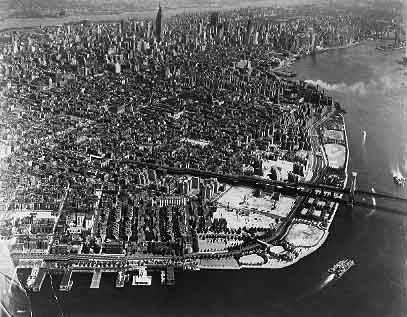Twenty-six year old Robert Icard arrived in New York City with his young family in tow. Leaving the port city of Baltimore, he had aspirations of making a better life for himself and his future generations. He settled in a neighborhood known as Corlears Hook and would operate a shot manufacturing and gunsmith company from the lower level of his home on Water Street. The year was 1820 and Corlears Hook was beginning the descent from middle-class neighborhood to skid row. Once a Native American Settlement and then an industrious shipyard, the neighborhood was about to become a virtual red light district filled with violence and thievery. Some years later, the Brooklyn Daily Eagle would describe it as “the Five Points of its day and the inhabitants were the vilest of the vile, male and female.” What was this area that Robert Icard moved his family to and what remains of it today?
Picture yourself as a curious outsider in the mid to late 19th century, wandering around the vicinity of today’s Grand Street exit off the FDR Drive. Raucous saloons with monikers like Tub of Blood, Hell’s Kitchen, and Cat Alley dot “the Hook”. Think twice about stopping in for a pint of ale or a plate of oysters along the shoreline, for bandits and thieves would prey on the unwelcome. The ghost of Helen Jewett walks beside you as you encounter a row of brothels on Walnut Street (today’s Jackson Street), filled with women of the night competing for your business. Possibly armed with doses of “knockout drops,” your pocket watch will surely disappear.
On Grand Street, overcrowded tenements housing newly arrived immigrants looking for work, are filled with squalor and darkness. Maybe one of these dreary walk ups is the birthplace of the notorious Edward “Monk” Eastman. Continuing down the renamed Jackson Street, you spot one of the numerous, decrepit, docks lining the foggy East River. Chatter and wicked laughter can be heard throughout the thick sea air, as you peek under Pier 57. Encamped around a small fire divvying up loot is the murderous Short Tails Gang.
Headquartered on the corner of Rivington Street and Goerck Street (today’s Baruch Playground), the Short Tails terrorized the Corlears Hook docks by robbing, beating or murdering incoming boats and sailors. Not wanting to get involved with such a brutal crew, you walk along Cherry Street only to encounter the Daybreak Boys, the greatest of the East River pirate gangs. Known for sabotaging boats in early morning hours, they are rumored to be responsible for up to 40 murders in a two year period. Further down the waterfront, Patsy Conroy has recruited some of the most infamous thieves to inherit the mantle as the most dangerous gang in Corlears hook. Luckily, the failed Mattan Robbery would be the undoing of this gang.
Continuing your walk, one last obstacle awaits. The Hook Gang, the last of the river pirate gangs. They number about 100 and are known to hijack incoming boats while blocking off streets leading to the docks. Thanks to the newly formed Steamboat Police Squad, the Hook Gang and the era of river piracy is about to come to an end and the Corlears Hook cleanup is about to begin.

Habitation of Corlears Hook can be traced back to the Mareckawick group of the Canarsee Native Americans. The Mareckawick group claimed ownership to most of the islands in the East River and were based out of present day Brooklyn. Naghtongh, as they called their settlement, was covered with marshy swamps and beachland. The shoreline of this period is where today’s Cherry Street is located and was shaped at an incline. This feature was used as a canoe launching site and provided protection from enemy tribes.
With the arrival of the Dutch, tracts of land were sold to wealthy merchants who would build estates and plantations. The area of Naghtongh would be granted to Jacobus van Corlaer, a schoolmaster, in 1638 and renamed Corlaers Hoeck. In 1652 he sold the land to a Dutch magistrate named William Beekman.
The year 1643 would mark the beginning of the end for the Canarsee and the neighboring Lenape tribe. Willem Kieft, a Dutch merchant who became Director of New Amsterdam attempted to drive out the Native American tribes. On February 23, 1643, Kieft would lead a slaughter of over 100 Native Americans that became known as the Massacre at Corlears Hook. News of this angered the Dutch who had learned to peacefully coexist with the Natives. Soon after, the Dutch would replace Kieft with Petrus Stuyvesant. Relations with the Natives and the Dutch would not return to normalcy. Distrust and skirmishes between the two groups would continue and the Dutch population would decline. 1664 would bring the arrival of the British and a dramatic change for the neighborhood.
Now under British control and rebranded as Crown Point, the Hook for years would be lined with busy piers, sail and rope manufactures, blacksmiths and gunsmiths. Industry was on the rise as today’s Grand Street became known as the Road to Crown Point. Even after the American Revolution and anglicized to it’s original name, Corlears Hook, this once bucolic land would become one of the leading shipbuilding manufactures in the young nation.

So how did this thriving neighborhood take a turn for the worst? One early cause was the British seizing over 1 million tons of American shipbuilding material during the War of 1812. This left thousands of workers unemployed in their field. It was written in an 1878 Brooklyn Daily Eagle article, “Today go to Corlears Hook where 15,000 men used to be employed at building the navies of the world, and you will find the great works turned into stables, marble yards and not a trace of shipbuilding.” An influx of poor German and Irish immigrants looking for housing paved the way for cheap and crowded tenements; the first being erected in 1833 on Water Street in Corlears Hook. With sailors indulging in the numerous saloons along the waterfront, prostitution became prevalent. Legend has it, the ladies of the Hook became known as “hookers.” The rise of the river pirate gangs made the Hook a bloody battlefield. They would fight, rob, and murder anyone in their path. The looting of arriving ships was not uncommon, nor were the dead bodies left in the path of these colorfully named gangs. Describing the Hook, the New York Times would proclaim, “…many daring deeds of villany have been consummated in its malarious slums…”

In the 1890s, social reformers such as Jacob Riis began to take notice of the conditions in which the less fortunate lived. The implementation of strict housing laws and demolition of decrepit tenements would bring an end to skid rows around the city. The relocation of shipping to the west side of Manhattan from Corlears Hook was the final blow to the blighted district. The dilapidated shipyard docks would be razed and landfill would cover the waterfront. In the middle 20th century, public housing replaced tenements and the FDR Drive would line the East River.
At an 1895 meeting, the twelfth precinct police captain would report to the Advisory Committee on Small Parks, “The Hook Gang is gone. It has disappeared since the establishment of the Corlears Hook Park”. Corlears Hook Park would have the distinction of becoming one of the first municipal parks in New York City. Located at the intersection of Cherry Street and Jackson Street along the FDR Drive, it displays such amenities as playgrounds, a spray park, a dog run and a soccer pitch. The park is one of the only vestiges remaining of a bygone neighborhood.

In 1840, perhaps fed up with the wretchedness of the Hook, the Icard family would leave New York City for the greener pastures of New Rochelle. 197 years after Robert Icard’s arrival, his great-great-great-great-great grandson would work on the same Corlears Hook streets and pen a story about his family’s lost Lower East Side neighborhood.


Michael is a New York City history buff, amateur genealogist, and a member of the New York law enforcement community. His NYC roots go back to 1820 on Water Street and the Vinegar Hill section in Brooklyn.
